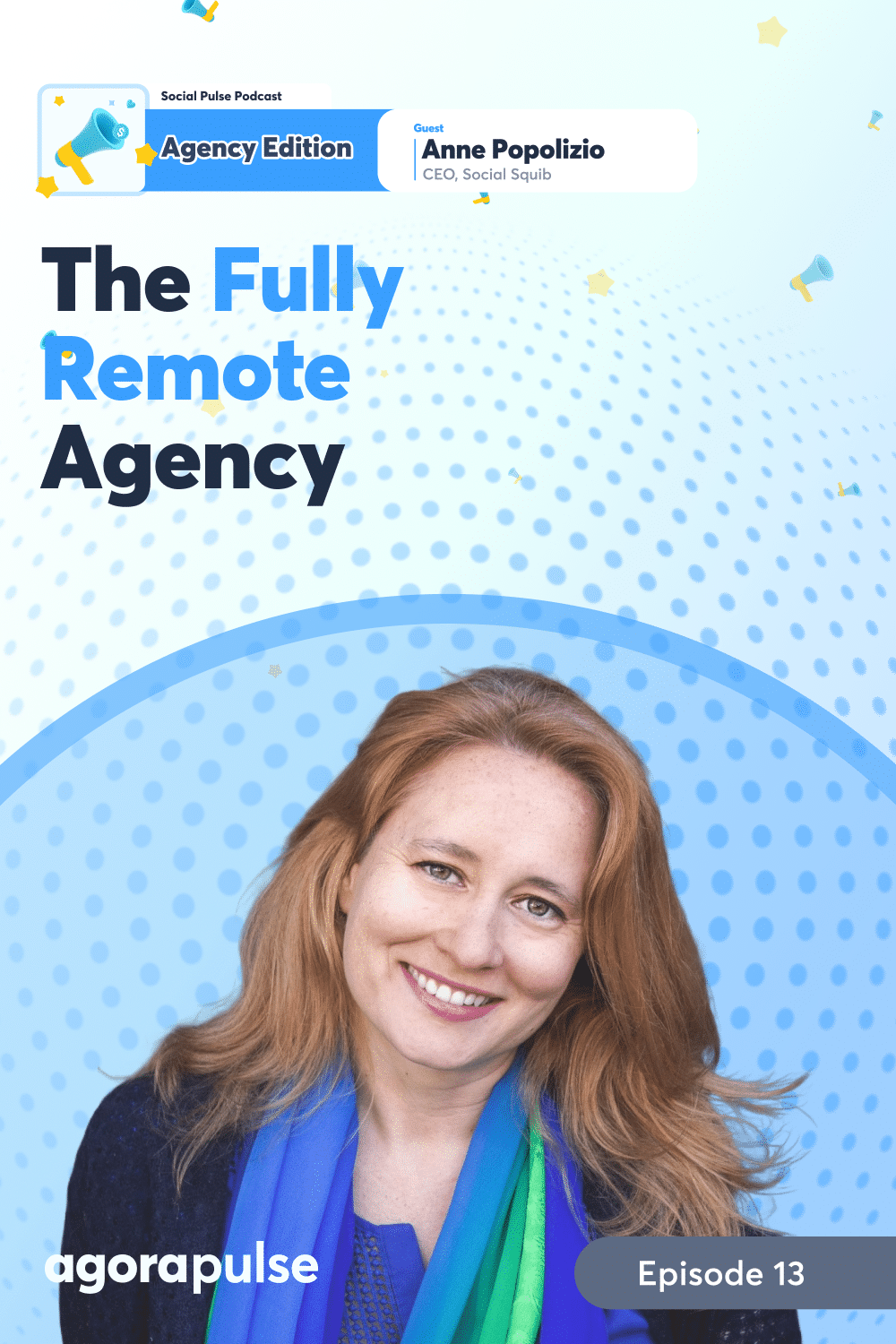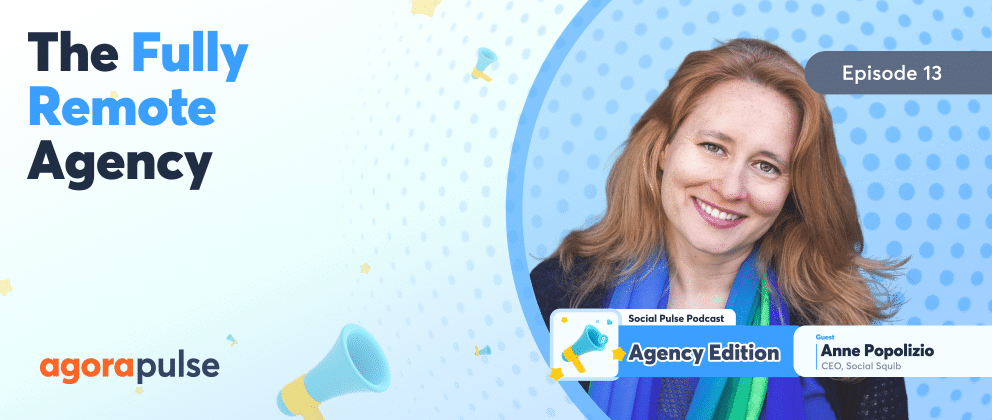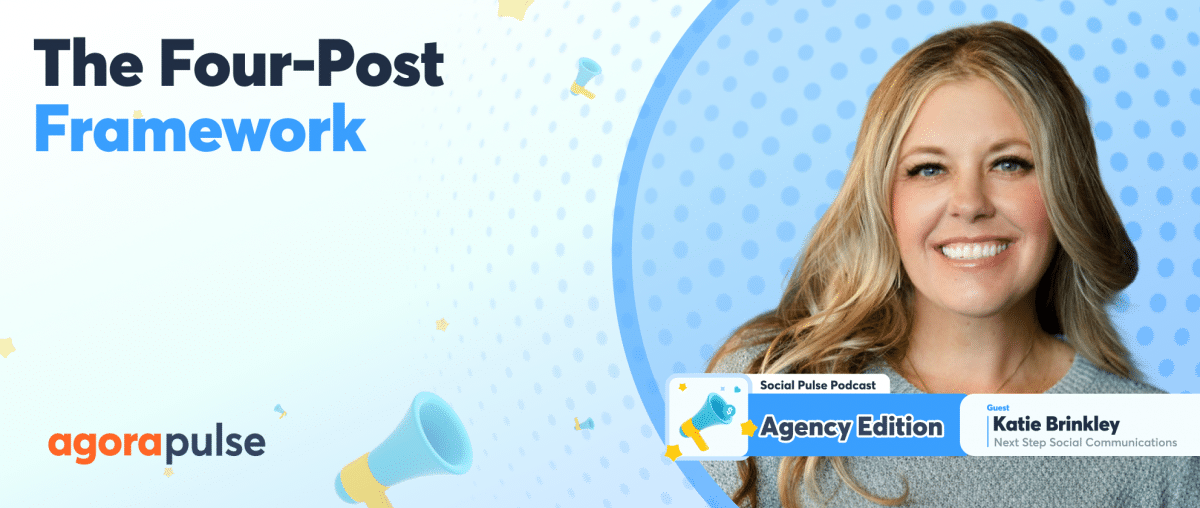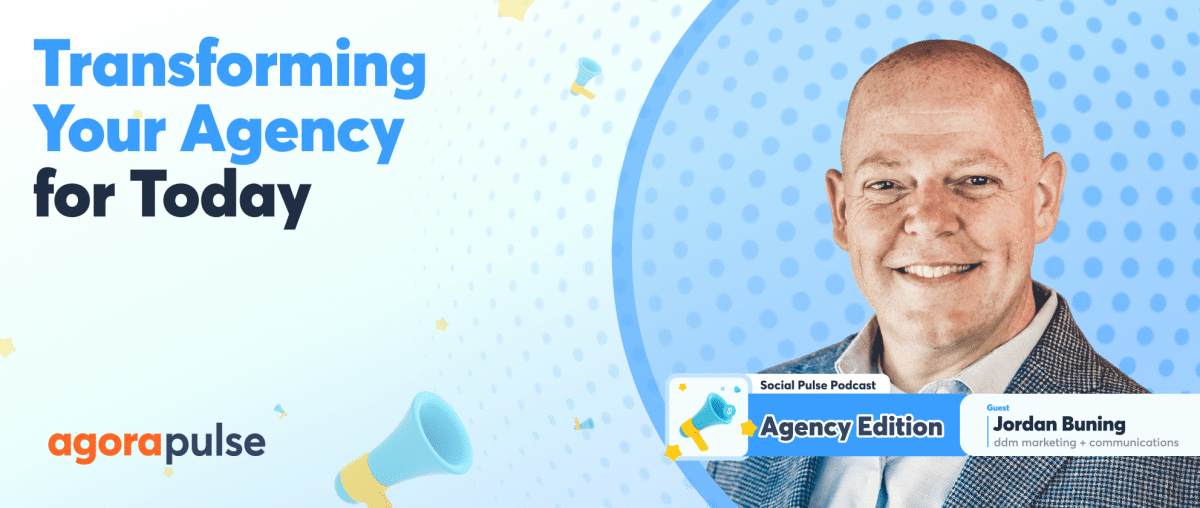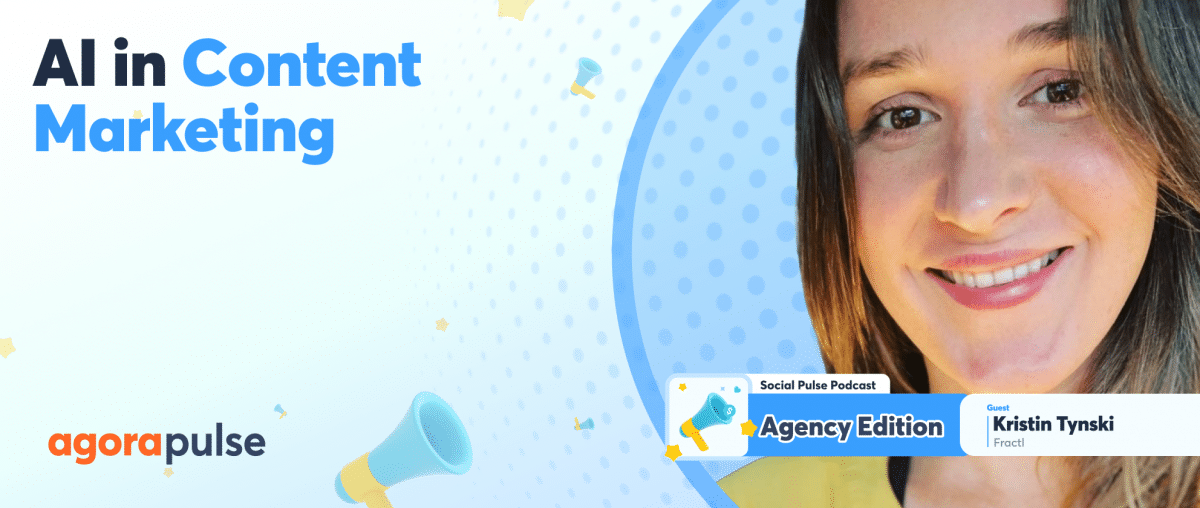Whether you’ve intended to build a fully remote agency or that’s your goal, managing remote employees has its own challenges and opportunities to say nothing of being remote yourself as an agency owner. How do you line up clients? How do you ensure communication within your team? How do you even juggle time and time zones?
That’s exactly what Anne Popolizio is going to talk to us about. Anne is the owner of the digital marketing agency, Social Squib, a fully remote digital marketing agency. Her goal is to not only build a remote agency, but to be a geographically independent agency owner herself which she’s accomplished. She has been doing social media for businesses since 2010 and knows how to leverage their social media following into clients. And she’s obsessed with analytics, so that clients can measure the results of their efforts.
To listen to the full episode, check out the Social Pulse: Agency Edition:
The following is a transcript from today’s episode.
What Is Social Squib?
Mike Allton: So glad to have you. So glad to have these conversations with you. We’ve gotten to talk at a number of times during summits and that sort of thing. It’s always a pleasure.
Can you start by telling us a little bit more about how you started or even why you started Social Squib and the kind of work you’re doing today?
Anne Popolizio: A big part of the motivation was that I needed at the time to be geographically independent, and I had a friend that had started a virtual assistant company. And I talked to her a little bit, and she had a degree in marketing and she was like, “Oh, we were talking about the things that I knew how to do, things that I was doing in my current job.” And at the time I was responsible, I was the director of a sailing school, and I was responsible for all of their marketing. And we’d had 30% growth in programming revenue two years in a row.
I knew that I wasn’t terrible at it. And I was talking to her, and she has this degree in marketing, and I’m telling her, “Well, this is what I do. We’re doing social media. We’re running ads. I’m running the banner over PCH. I’m going to the kids’ camps and collecting email addresses. I’m sending email marketing. This is everything that we’re doing.”
And she was like, “I wouldn’t touch social media with a 10-foot pole. I know nothing about it.” And I was like, “Oh, I’m cool. I hope you’re all doing well, and I’m sure you’re all doing well, and I’m sure you’re all kind of good at it.”
So I very quickly ditched the virtual assistant idea. “You know, the sky’s the limit. If I go the agency route, the sky is the limit.”
I started Social Squib the following year, and I had left LA. I had packed up everything I owned, sold most of my furniture. I think I had three boxes of stuff that would fit into my car, and I think I shipped two boxes, and then everything else that would fit into my car, my cute little Nissan Versa—and then I drove across the country, dumped a bunch of stuff at my mom’s house, and then proceeded to start traveling full time for, well, that was [in] 2016.
And that is why we started it. And then I went from there. I mean, I had the initial idea. I was like, “I was going to be like an outsourced marketing director, maybe have three clients.” And I ended up learning how to do paid social correctly. And the next thing I knew, the only thing anyone wanted to talk to me about was paid social.
And so we became a primarily paid social agency. And then as the team has expanded, we have grown, and we were close to full service. We do the full lead generation funnel. We do organic social media, email marketing, etc. The only things we don’t do are SEO and full website development.
Finding Your Geographical Independence
And more importantly, you mentioned you’re geographically independent.
What does that even mean? And what have some of the benefits been to you over the years?
Anne Popolizio: It means that I don’t have to be in any one place at any particular time, which also means that I can be wherever I want to be whenever I want to be there.
So for me, that means that I spend most of my time—about half the year in the south of France. I maximize my 90 out of 180 days within the Schengen territory, and then I spend the rest of the time typically in the States. I will usually do a month or two in California, the rest of the time in New Jersey. I do try to do a discovery place every year, so I did a month in Mexico. I did two months in Croatia. I did a month in the Bahamas. Then, you know, so wash, rinse, repeat. I’m in Nice now. Yeah. I have an apartment in Nice.
Mike Allton: That’s awesome. And can I just say for the record, I’m super-jealous, but that kind of arrangement—it’s not without its challenges, right?
What are some of the obstacles that you’ve had to overcome with this model, not just as an employee, but as an agency and an agency owner?
Anne Popolizio: Personally, for me, I’ve always had a remote component to my entire career. I started my career off as an actor.
Going all the way back to that point in time, the biggest hurdle that I had to overcome was how to work without external motivation. And, you know, you come out of school, and you’ve always got a deadline, and you’ve always got to live to please. All of a sudden, the work wasn’t going to get done unless I did it.
So I had to learn very quickly how to do work for myself and accomplish goals for myself.
But it’s definitely very easy to find yourself—even after I started Social Squib—find yourself kind of languishing a little bit. It’s really easy for days to go by, and you can look up and be like, “Oh, I never did that.” And so I have built a lot of infrastructure for myself around what I know are my weaknesses and, interestingly enough, I mean, some of that is I need a little bit of external motivation. So I have structured the business to make sure that Anne has her motivation where she needs it.
One of the earliest things that I did was I started implementing weekly meetings with our clients. A lot of agencies only meet with their clients once a month. I needed a weekly meeting. That meeting is not for my clients. That meeting is for me.
The result is that it means that the work keeps progressing. And I think it actually creates a very good rhythm for our clients. It creates a very predictable rhythm for our clients.
And so from first idea to campaign build. We have a very consistent process. We do the designs, we write the copy, the client reviews them. Once they approve, then we’ll do proofs. And then once they approve the proofs, then we finish the build and we move forward.
But I had to build a lot of infrastructure for myself to make sure that I didn’t get lost in my own weaknesses, which is when I need a good kick in the pants sometimes. And that was how I addressed that particular issue.
Another issue that we’ve had, obviously, is time zones. Time zones are definitely a challenge, and managing a team remotely hiring has been a challenge, because you trust. Trust is a big issue. You have to really trust someone when you’re working remotely, and you can’t be there to monitor them. You can’t see exactly what they’re doing. You can’t be looking over their shoulder.
So that’s always, always a tricky one. I do keep hiring very close to the chest. Strong referrals from people that we already know, people whom I personally have already met.
Challenges with Remote Agencies
Mike Allton: What about some of the other challenges that are just inherent to any kind of remote agency, even if they’re all in the same time zone? But they’re not necessarily in a place where they’re all coming to the office which is the case with your agency.
How are you dealing with things like just team building and teamwork and team communication?
Anne Popolizio: That’s been a tricky one that I’ve had to work pretty hard to address. And it’s hard because our team is really spread out. It’s not like we’re all in the same state or even the same time zone. I mean, we spread across the entire country. And so bringing everybody together physically would be in a lot of ways prohibitively expensive.
- Team meetings. What I’ve done is I’ve implemented all team meetings. So every month the entire team comes together, and it’s not that we’re not a huge company. We don’t have massive things that need to be addressed. I have one-on-ones with every single person every week, sometimes more than once a week. But we sort of bring together different projects. Everybody, so that they can meet each other and communicate with each other and share ideas and brainstorm and just get to know each other.
- Horizontal communication. My big concern is if something happens to me, it’s the weak link in the business, right? If I get hit by a bus tomorrow, God forbid, the whole thing falls apart. I realized last year that I really needed to start addressing that and create more horizontal communication. And so I’m starting to where possible start to step out, start to facilitate more horizontal communication. I’ve got my organic social managers talking directly to the designer, rather than things having to funnel through me.
- Company culture. I mean, company culture is a hard one, but at the same time, our company culture is how we live, which is how we come together. We do the highest quality work that we can, but we also get to live our lives. That’s a major part of our company values is that this business is created to support life and to support how we live. So I’m okay with maybe we lose a little bit of team building. But we make up for it in the fact that social scope facilitates all of us to live our lives the way we want to live our lives.
Advice for Remote Teams
Mike Allton: So now for agency owners who are listening, who may be either managing fully remote teams or they’re thinking about launching a fully remote team.
What advice would you give them?
Anne Popolizio: You have to be very structured. You have to be very structured in your communication.
I am very anti-Slack, for example. We have regularly scheduled short meetings with the team. Each team member, at a minimum, I meet with once a week, depending on how much work they do for us. Some team members I meet with twice a week. And then obviously there’s communication in between if needed. We do everything through Airtable.
I am a big believer in not having diluted communication, and that’s part of why I dislike Slack because I find people trying to have communication via chat that really needs to be discussed over a phone call or a video chat, with a clear decision and clear outcome. And then if I give something to the team member, it goes into Airtable. The whole communication thread is in Airtable.
Oftentimes a few clients send an email, or they’ll send us back a message, and they’ll be like, “We want to talk about this,” or “What do you think about this?” I’m like, “I’ve added this to our call agenda.”
We eat, sleep and breathe call agendas. We eat, sleep and breathe Airtable. And we’re very structured in our communication. And that’s how things don’t get lost. And that’s how we keep our project management going.
The other thing that I personally do, I have a very strong routine to start my day.
I will take the first—anywhere from six to eight. And I will review everything that was on my list from yesterday, and then I check off what got done and then I transfer the new stuff that came in into my master to-do list, and then I identify what are the things that I’m personally going to get done for today. I have an accountability buddy. We just celebrated, I think, 12 years and, so she and I, we email every single day. So everything, every single day, we send an email to each other. So I know exactly what I did, what I have planned for the day. And I take that time. So that’s how I’m able to, as I go through the day with meetings with clients and things, I don’t try to like get things into Airtable in real-time.
I write it down in my notebook, which is always sitting right next to me. And then in the next morning it will get transferred to the big list. And then if it needs to get delegated to one of the team members, that’ll go into Airtable. So I have a very strong routine to start my day, and that’s how I ensure that things don’t get missed.
And then I have my meetings, my one-on-ones with my team members, and we review the Airtable and have statuses for everything that I give them. So we’re very organized in that regard.
So, yeah, communication, organization, but then you also have to create room for the water cooler. You need water cooler time, and I’m not good at the water cooler stuff. I’m not good at small talk. I’m not good at the chit chat. I’m the kind of person where I’ll write the email, and I have to revise it three times so I don’t sound like a jerk when I send it. “How are you? Hello?” I have to remind myself to put those things into an email. but I do try to make an effort to have a little bit of water cooler time in meetings, check in with my team members, ask them how they’re doing, how was their weekend, and same with clients. I have a little bit of water cooler time at the beginning just to give a little bit of a check in, and then we’ll dive into the agenda.
Mike Allton: I think that’s one of the reasons why you and I get along so well is that we don’t really require that water cooler time. It’s been weeks, months, since last time you and I spoke to each other in person, and we just jump right in, and half the time it’s straight into some other marketing topic, whether it’s personal or professional or whatever the case might be.
I really liked the way that you’ve got your day organized. I feel very similar. The tool’s a little bit different. We [at Agorapulse] use Asana instead of Airtable. I’m a very digital guy. So even though I have a physical notebook, that’s like my emergency. If I’ve got to write something down right now, my to-do list is in Evernote. So I’ll have that next to me. And it’s a duplicate of what I have in Asana, but Asana’s a little busy. I don’t want to have to poke around in different projects where here I just have, “This is it, this is what I’ve gotta accomplish today. And it’s a long list.”
SEO and Measuring Organic Traffic
Mike Allton: You were talking about how your agency does almost everything except for SEO and web.
So you do organic. And one of the common threads and topics on this show is the challenge agencies have to actually demonstrate the value of organic social media to their clients. Paid is easy from a demonstration perspective. You’ve got the reports, right? I mean, it’s not necessarily easy to achieve results, but when you do, the reports are right there. We did it. Organic.
How are you measuring the business impact of social media?
Anne Popolizio: I would say they’re very similar. I think I would say it’s a misconception that tracking and reporting for paid versus organic is actually all that different. That’s okay.
- Here’s the thing, right? So, yes, within ads manager, for example, supporting Facebook ads with an ads manager. I can get event tracking. I can set up on my website, and that can send my information sentences here. I can get the event conversion information right next to my campaign information.
- Yes, that is true with an ads manager. I don’t have that organically. I’m not going to get the event firing back to my organic.
- But it is very possible to get all of this information in one place, and that’s through Google Analytics, and that’s actually what we use primarily to measure the effectiveness of our report of our campaigns, paid or organic, especially with iOS 14. Five changes that came into play 2 years ago now: There was attribution loss, and Facebook’s information was reduced. And so we switched over prior to iOS 14.5. We did use ads manager as our primary reporting source for conversion measurement after I was 14.5.
- We just switched over to Google Analytics. The report I pay attention to most is what’s in Google Analytics. And we use Looker Studio to build out dashboards for all of our clients. And so we can see organic and paid conversion rates right next to each other in Looker Studio, pulling in via the Google Analytics data. And we use UTMs on our paid social just as we use UTMs on our organic social.
So we are Agorapulse clients, and so it automatically tags with the source and the medium. So we know if a link came from organic social media—not that there’s a ton of links going out within the confines of the host—but when there is that link is automatically tagged and then if that person does convert, then we can see.
The other piece of behavior that we’ve discovered is that a lot of people go, even if there was a link, whether they’re coming in by organic or they’re coming in by a paid—and I don’t quite have the detail, the data around this to prove this—but this is a strong suspicion because I know where the volume of impressions is coming from, but a lot of the organic traffic comes from the profile link.
And so we have our profile links tagged as profile links. And so I can see when people are coming specifically from the profile link. And then if you have a campaign tagged, I can see the campaign data. So I’ve got organic and paid social tagged properly. So that all pulls into Looker Studio. And then certainly on every paid ad, we have the campaign. So I immediately get the paid campaign breakdown, and then I get the leads that got generated from those campaigns right there in the Looker Studio report.
So that’s the long version to the answer to your question. We use Looker Studio and Google Analytics.
Mike Allton: I think the key takeaway there is to make sure that every single link that you’re sharing, whether it’s paid or social or paid or organic is tracked UTM parameters.
Like, you said, if those of you listening, if you’re using Agorapulse, we’ll track that automatically for you. We’ll even integrate that Google Analytics data and surface that in a nice report. So you’ll be able to see any traffic that you sent from any individual post. Did it go to the website? Did that person do something? We’ll bring that back. We’re actually integrating and releasing very soon a connector to Looker Studio directly. Training very soon. By the time you’re all listening to this podcast, that integration, that connector is probably out. Don’t quote me on that, but it’s coming soon, and we’ll have some training available soon as well.
But one of the questions I wanted to ask you—and because you’ve been doing this for a while—you’ve worked with many, many clients. And I’m sure not all the clients that you’ve worked with have been angels. I’m sure some of them, probably a little less than angels.
What Shouldn’t Clients Do?
Anne Popolizio: Throwing a temper tantrum. That will get you fired. And it has.
Basically, if you treat us poorly, you’re out. We’re all on the same team. You are a thousand percent allowed to have feedback. You are a thousand percent allowed to not like what I presented to you.
You’re going to be like, “Nope, this does not work for me.” What you don’t get to do is screaming at me that this is crap. That doesn’t work. You’re out. If you say, “This doesn’t work for me,” or “I’m not a fan of this,” that’s fine.
But if you do not treat us well, if you scream at us, you’re done.
Mike Allton: Good advice.
The reason I ask these questions is not because we’re talking to your target clients, but because we’re talking to other agency owners.
And I hope those of you listening [or reading!], what you take away from that is that: You don’t have to put up with that kind of behavior because some people think that that’s okay.
And they need to know that it’s not okay. And they need to know that they can’t just go from one agency to another one, treating them horribly.
What’s in Anne’s Tool Stack?
My last question: What tools haven’t we talked about that are in your tech stack?
Anne Popolizio: Google Drive. Everything is in Google Drive. We are an entirely cloud-based agency for obvious reasons, we are not all hanging out in the same building on the same server. So Google Drive, we do everything via Google Drive and then Canva—we use Canva for our design again because it’s a cloud-based design software that we needed.
Drive, Canva, and then the video editing. The video editing is always the tricky one. Canva’s come a long way in terms of what you can do with video, but it’s not really an editing software yet.
There’s a lot you can do in terms of creating slideshow videos, and we definitely do a lot within Canva, actually, for social video—but as far as real editing goes, that is, we have a couple of different software.
We’ve used Wavve for a long time. We were in a different one before, and then we switched to Wavve …We use Wavve mostly now at this point for captions and for editing actual video footage where it started off as a video, and we’re cutting together a video, and we’re cutting out the ums and this and that, all the little interstitials.
Mike Allton: I totally feel you on the video stuff. I still use iMovie on my Mac for all my video editing because it does what I need it to do.
Anne Popolizio: It’s fine if it’s just you, but as soon as I need to be able to get in there and review it before it’s published, we can’t be dealing with downloading every single one of these files for me to review it for you, that then it’s for me to give you edits to, then you’d go back.
We were reviewing videos today, and we were editing them together in real-time, and she [my editor] was able to just go in and tweak, tweak, tweak, tweak. Then I could get feedback, and I could play it on my end to make sure there’s no weird issues, but we have to be able to work in tandem with each other around the video editing.
Canva has come a very, very long way.
Mike Allton: I do love Canva. I’ve been a Canva user for years, and I was recently shown by Adobe Express. Adobe showed me Express, where it’s come, and it’s come a long way.
There are going to be actually a big part of our agency summit in June. So for those of you listening or reading, mark down June 20th on your calendar for our agency summit, we’ll be joined by TikTok and Adobe and LinkedIn and a couple of other major brands talking about their solutions and how they can help you as an agency speak to your clients more.
But Express is something I want to look into a little bit more because they’ve got so many cool AI based features that are kind of amazing.
Anne Popolizio: The big one we’re talking about right now is like getting, you know, taking a 30 minute video and clipping it up for short social videos. That was the topic of the conversation today.
It’s like, “What are our options for that, specifically?”
Mike Allton: Yeah, Opus Clip is good for that. And for those of you listening who want other ideas, go follow my other show, the MarTech Show, because we’re often bringing on brands and solutions that do exactly these kinds of things and doing deeper dives.
This has been such a cool and fun interview for folks who want to learn more about you and Social Squib. Where can they go to find and connect with you?
Anne Pooplizio: SocialSquib.com, and we are on Instagram at SocialSquib. We are on the Facebook at SocialSquib. Those are your best places. Or LinkedIn. You can connect with me on LinkedIn as well.
Follow us on LinkedIn, send me a message, say hi.
Thanks for reading this transcript of the Social Pulse Podcast: Agency Edition, where every week we’re talking to marketing agencies like you, going through many of the same struggles you’re going through and sharing their stories. Subscribe to find in each episode, inspiration, motivation, and the perspiration that goes into growing and scaling agencies like yours. We have the links to all of Anne’s sites and everything that we mentioned today in the show notes. And don’t forget to follow us on Apple, folks, and leave us a review. We’d love to know what you think.
